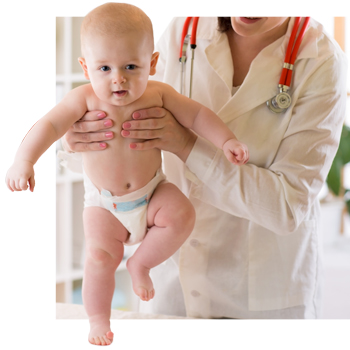
Cerebral palsy, or CP, is the most common disability affecting the motor function of young children. This condition may be caused by brain damage the child suffered during pregnancy, labor or delivery.
If the brain damage was caused by medical malpractice, the child’s parents may be able to file a medical malpractice lawsuit to recover compensation for the treatment and management of this permanent disability.
The cerebral palsy lawyers of Janet, Janet & Suggs work to aid families in gaining the compensation they need to adequately manage symptoms of CP.
Cerebral Palsy Symptoms
Children affected by CP may display many impairments that can support a diagnosis. Your child’s impairments may be mild or severe and difficult to discern if you do not know what you are dealing with.
These are the eight signs of CP clinicians look for when attempting to make a diagnosis:
1. Muscle Tone Impairment
Good muscle tone allows a child to sit, stand, and hold his or her body upright without help. However, CP can cause abnormal muscle tone in various parts of the body, causing the child to display the following symptoms:
- Hypotonia – This is decreased muscle tone resulting in floppy or relaxed limbs.
- Hypertonia – This is increased muscle tone that creates stiff limbs.
- Dystonia – This is where muscle tone is too loose in some places and too tight in others.
- Joints that are fused together – This prevents proper motion of the joint.
- Muscle spasms – This includes clonus, or muscle spasms with regular contractions.
2. Impaired Movement, Control and Coordination
Poor muscle tone associated with CP also affects a child’s coordination, movement and body control. You may notice:
- Spastic movements, especially under stress
- Dyskinetic movements due to fluctuations in muscle tone
- Poor coordination and balance
- Gait disruptions such as limping, toe walking, in-toeing and out-toeing
3. Abnormal Reflexes
Babies begin to display some primitive reflexes following birth. These should disappear throughout the child’s development. If they do not, they could be signs of CP.
These primitive reflexes include:
- Turning the head and extending the legs on the same side of the body while the opposite side contracts, also called the asymmetrical tonic reflex
- Crawling with the head extended, also called the symmetrical tonic neck reflex
- Arching the back, straightening legs and bending arms as the head is tilted backward, also called the tonic labyrinthine reflex
- Grasping motions when the palm of the hand is stimulated, also called the Palmer grasp reflex
- Extending arms when held in a manner where legs are above the head, also called the startle or Moro reflex
4. Asymmetrical Posture
Posture is typically symmetrical, though in children with CP, you may notice that one side of the body does not mirror the other.
You may also notice that your child is not developing other typical postural responses, such as:
- Landau reflex – When sitting, lifting the head should cause the legs to rise while pushing the head down will make them drop.
- Parachute response – When the head is toward the ground, an infant should reach out like he or she is bracing for impact.
- Head righting – If swayed back and forth, the head should stay straight.
- Trunk righting – When swiftly pushed sideways while sitting, force is resisted and the opposite hand and arm are used to brace for impact.
5. Poor Balance
Because CP can impair a child’s gross motor function, many children with CP have balance issues.
Signs of poor balance include:
- Child needs to support his or her body with both hands while sitting and struggles or is unable to balance without that support
- Swaying when upright
- Unsteady walking
- Abnormal gait
- Requires hands for balance
6. Impaired Gross Motor Function
Gross motor function allows a child to move and coordinate large limbs such as the arms and legs. A child with CP may have difficulty, either impairment or delay, in reaching gross motor milestones such as:
- Sitting
- Rolling over
- Crawling
- Standing
- Balancing
- Walking
7. Impaired Fine Motor Function
Fine motor function refers to a child’s ability to perform smaller movements of the hands, fingers, feet and toes. Development of these skills may be impaired or delayed in a child with CP.
Children with this disability may struggle with:
- Grasping small items
- Pinching an item between the forefinger and thumb
- Placing an object down with care
- Grasping crayons
- Turning a book’s pages
8. Impaired Oral Motor Function
A child with CP may have difficulty making movements with his or her jaw, tongue or lips. Impaired oral function is seen in up to 90 percent of CP patients of preschool age.
A child with CP may have impairments in the following areas of oral motor function:
- Talking
- Swallowing
- Chewing
- Drooling
- Breathing
- Articulating
- Closing the mouth
- Moving saliva in the mouth
- Tongue thrusting
- Choking
- Gagging
Schedule a Free, No Obligation Consultation to Discuss Your Legal Options
If the cause of your child’s cerebral palsy was negligence, you may be entitled to compensation that will help you best manage your child’s ongoing healthcare needs.
The cerebral palsy lawyers at our firm may be able to pursue a legal claim, working to secure all of the compensation your family deserves.
We work by contingency only, meaning you only pay if we are successful in recovering compensation for your child’s CP. Your initial consultation with our team is free and there is no obligation to pursue legal action.
Contact our firm today by calling 1-877-692-3862 or completing our Free Case Evaluation form.
RELATED POSTS
Cerebral Palsy Settlements
